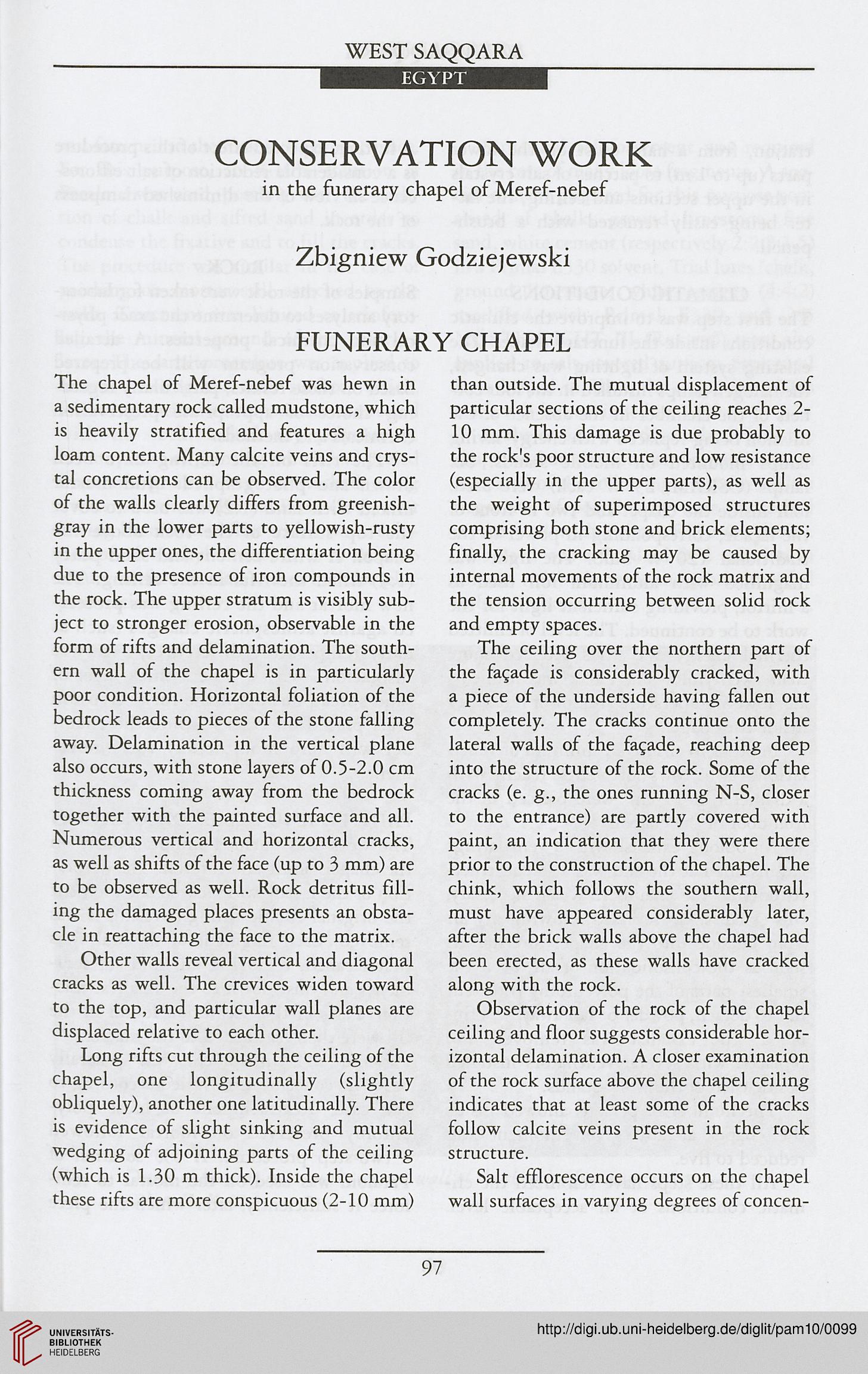_WEST SAQQARA_
EGYPT
CONSERVATION WORK
in the funerary chapel of Meref-nebef
Zbigniew Godziejewski
FUNERARY CHAPEL
The chapel of Meref-nebef was hewn in
a sedimentary rock called mudstone, which
is heavily stratified and features a high
loam content. Many calcite veins and crys-
tal concretions can be observed. The color
of the walls clearly differs from greenish-
gray in the lower parts to yellowish-rusty
in the upper ones, the differentiation being
due to the presence of iron compounds in
the rock. The upper stratum is visibly sub-
ject to stronger erosion, observable in the
form of rifts and delamination. The south-
ern wall of the chapel is in particularly
poor condition. Horizontal foliation of the
bedrock leads to pieces of the stone falling
away. Delamination in the vertical plane
also occurs, with stone layers of 0.5-2.0 cm
thickness coming away from the bedrock
together with the painted surface and all.
Numerous vertical and horizontal cracks,
as well as shifts of the face (up to 3 mm) are
to be observed as well. Rock detritus fill-
ing the damaged places presents an obsta-
cle in reattaching the face to the matrix.
Other walls reveal vertical and diagonal
cracks as well. The crevices widen toward
to the top, and particular wall planes are
displaced relative to each other.
Long rifts cut through the ceiling of the
chapel, one longitudinally (slightly
obliquely), another one latitudinally. There
is evidence of slight sinking and mutual
wedging of adjoining parts of the ceiling
(which is 1.30 m thick). Inside the chapel
these rifts are more conspicuous (2-10 mm)
than outside. The mutual displacement of
particular sections of the ceiling reaches 2-
10 mm. This damage is due probably to
the rock's poor structure and low resistance
(especially in the upper parts), as well as
the weight of superimposed structures
comprising both stone and brick elements;
finally, the cracking may be caused by
internal movements of the rock matrix and
the tension occurring between solid rock
and empty spaces.
The ceiling over the northern part of
the fagade is considerably cracked, with
a piece of the underside having fallen out
completely. The cracks continue onto the
lateral walls of the fagade, reaching deep
into the structure of the rock. Some of the
cracks (e. g., the ones running N-S, closer
to the entrance) are partly covered with
paint, an indication that they were there
prior to the construction of the chapel. The
chink, which follows the southern wall,
must have appeared considerably later,
after the brick walls above the chapel had
been erected, as these walls have cracked
along with the rock.
Observation of the rock of the chapel
ceiling and floor suggests considerable hor-
izontal delamination. A closer examination
of the rock surface above the chapel ceiling
indicates that at least some of the cracks
follow calcite veins present in the rock
structure.
Salt efflorescence occurs on the chapel
wall surfaces in varying degrees of concen-
97
EGYPT
CONSERVATION WORK
in the funerary chapel of Meref-nebef
Zbigniew Godziejewski
FUNERARY CHAPEL
The chapel of Meref-nebef was hewn in
a sedimentary rock called mudstone, which
is heavily stratified and features a high
loam content. Many calcite veins and crys-
tal concretions can be observed. The color
of the walls clearly differs from greenish-
gray in the lower parts to yellowish-rusty
in the upper ones, the differentiation being
due to the presence of iron compounds in
the rock. The upper stratum is visibly sub-
ject to stronger erosion, observable in the
form of rifts and delamination. The south-
ern wall of the chapel is in particularly
poor condition. Horizontal foliation of the
bedrock leads to pieces of the stone falling
away. Delamination in the vertical plane
also occurs, with stone layers of 0.5-2.0 cm
thickness coming away from the bedrock
together with the painted surface and all.
Numerous vertical and horizontal cracks,
as well as shifts of the face (up to 3 mm) are
to be observed as well. Rock detritus fill-
ing the damaged places presents an obsta-
cle in reattaching the face to the matrix.
Other walls reveal vertical and diagonal
cracks as well. The crevices widen toward
to the top, and particular wall planes are
displaced relative to each other.
Long rifts cut through the ceiling of the
chapel, one longitudinally (slightly
obliquely), another one latitudinally. There
is evidence of slight sinking and mutual
wedging of adjoining parts of the ceiling
(which is 1.30 m thick). Inside the chapel
these rifts are more conspicuous (2-10 mm)
than outside. The mutual displacement of
particular sections of the ceiling reaches 2-
10 mm. This damage is due probably to
the rock's poor structure and low resistance
(especially in the upper parts), as well as
the weight of superimposed structures
comprising both stone and brick elements;
finally, the cracking may be caused by
internal movements of the rock matrix and
the tension occurring between solid rock
and empty spaces.
The ceiling over the northern part of
the fagade is considerably cracked, with
a piece of the underside having fallen out
completely. The cracks continue onto the
lateral walls of the fagade, reaching deep
into the structure of the rock. Some of the
cracks (e. g., the ones running N-S, closer
to the entrance) are partly covered with
paint, an indication that they were there
prior to the construction of the chapel. The
chink, which follows the southern wall,
must have appeared considerably later,
after the brick walls above the chapel had
been erected, as these walls have cracked
along with the rock.
Observation of the rock of the chapel
ceiling and floor suggests considerable hor-
izontal delamination. A closer examination
of the rock surface above the chapel ceiling
indicates that at least some of the cracks
follow calcite veins present in the rock
structure.
Salt efflorescence occurs on the chapel
wall surfaces in varying degrees of concen-
97




